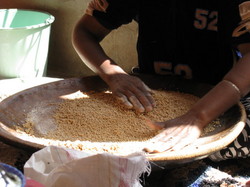Secret Kitchen menu, 20th Feb 2010
Gin, orange and pomegranate cocktail
Parsnip briwats, carrot salad, beetroot salad, cauliflower salad, herb jam, amlou (almond, argan oil & honey dip), Moroccan breads
Chicken couscous with onion & chickpea relish and harissa sauce
Citrus salad with pomegranate seeds and orange flower water
Almond ghoriba cookies and dates stuffed with pistachio & rose paste
Moroccan mint tea
About the meal:
Kemia – various salads, often made with cooked vegetables – are served at the start of a Moroccan meal, a bit like tapas in Spain or meze in Turkey. They are beautifully presented, to stimulate the appetite, and spiced with classic Moroccan flavours such as mint, parsley, pepper, cumin, cinnamon and citrus. The ‘herb jam’ (that’s what the cooks at Chez Panisse call it) is made with steamed spinach, kale, rocket and other greens.
In Morocco, couscous is a dish in itself, not something to serve with a tagine. (Tagines are eaten with bread.) I steamed the couscous the traditional way – three times over the vats of spicy broth in which I cooked the chicken and vegetables. In between each steaming, the couscous is moistened with salted water and rubbed between the hands. To finish it is rubbed through with butter, or smen – aged butter which tastes rather like blue cheese. The result, hopefully, is fluffier, lighter and tastier couscous.
Couscous can be made from wheat, barley or any other grain (in Mali we ate millet couscous). It’s likely the practice of making couscous (a form of pasta really) originated in sub-Saharan West Africa, and travelled north to Morocco. The picture above is of Fatima teaching me how to make couscous: using your hands, semolina grains are slowly coated in moistened flour until they form little balls, which are then dried outside. Today’s couscous was bought in packets from a shop on Blackstock Road. Maybe next time…
A Moroccan meal is likely to end with fruit, typically oranges and pomegranates. (Today’s fruits and many of the vegetables come from Riverford Organic, for whom I am now teaching cooking classes, to help people use up their weekly veg boxes).
 And of course there will be mint tea. After several classes in Morocco we think we’ve mastered the art: the green tea leaves are first washed in boiling water to remove any dust and some of the bitterness. Copious amounts of sugar (chipped off a conical loaf) and fresh mint are added, the pot is topped up with hot water, and then slowly brought to a boil on the stove. It’s supposed to be poured into glasses from a great height to create a foam on top – the sign of a good tea. As well as mint, we saw many other herbs used in Morocco – sage, rosemary, absinthe.
And of course there will be mint tea. After several classes in Morocco we think we’ve mastered the art: the green tea leaves are first washed in boiling water to remove any dust and some of the bitterness. Copious amounts of sugar (chipped off a conical loaf) and fresh mint are added, the pot is topped up with hot water, and then slowly brought to a boil on the stove. It’s supposed to be poured into glasses from a great height to create a foam on top – the sign of a good tea. As well as mint, we saw many other herbs used in Morocco – sage, rosemary, absinthe.

 Follow
Follow
Comments are closed